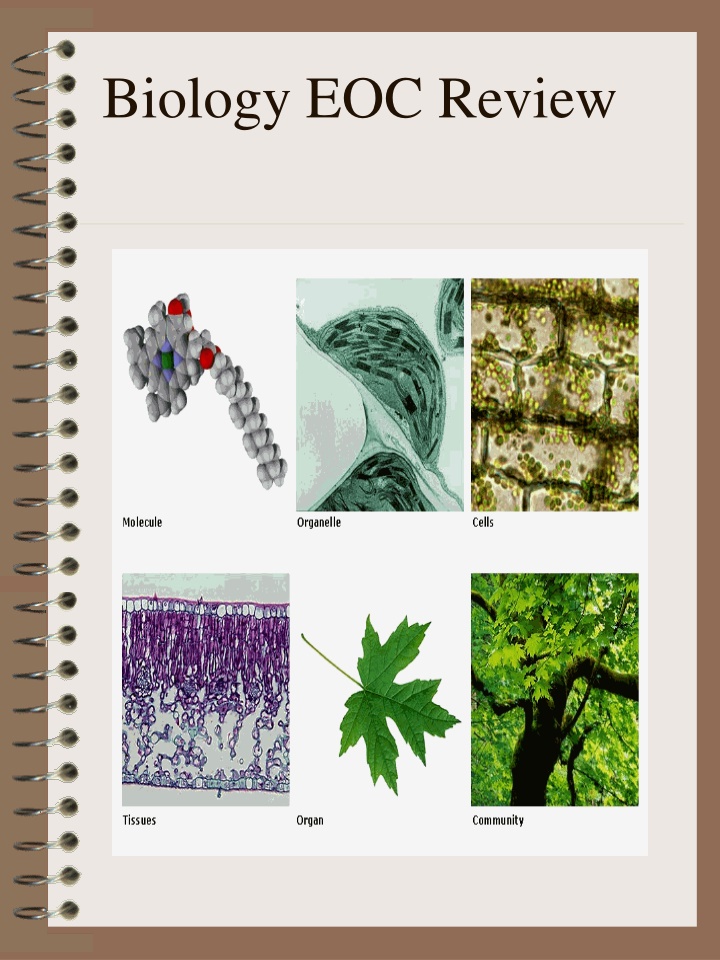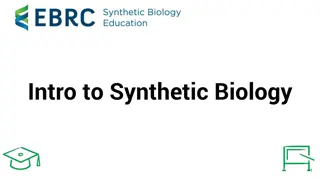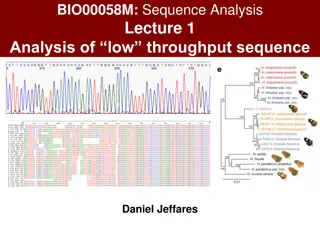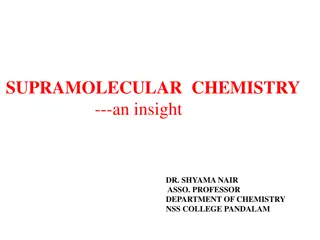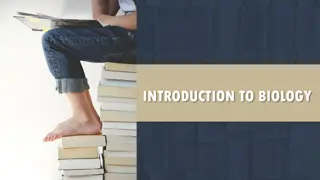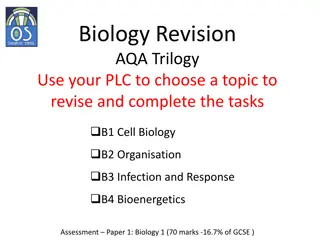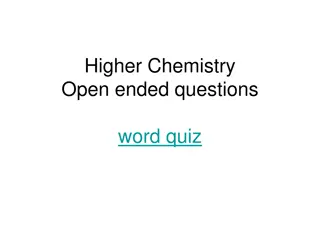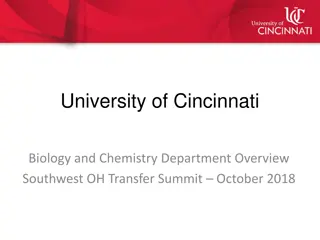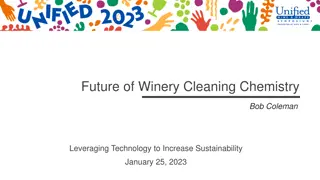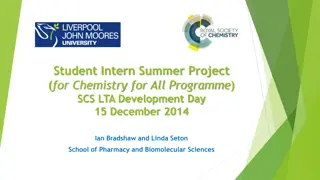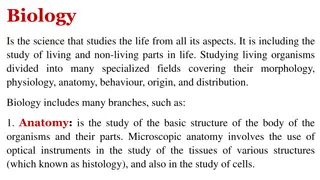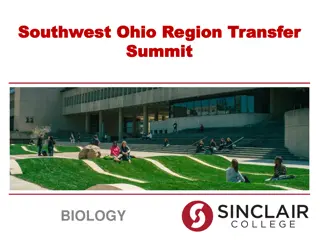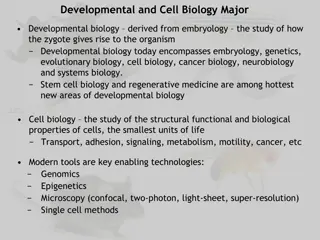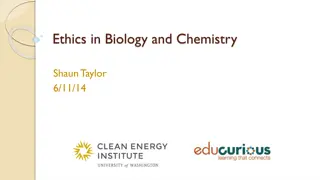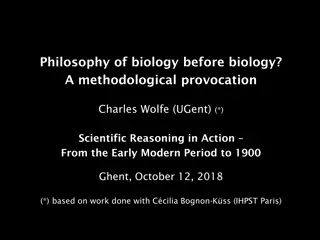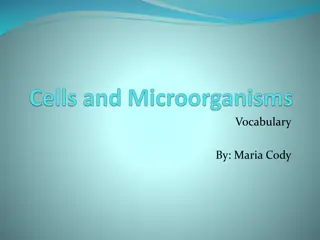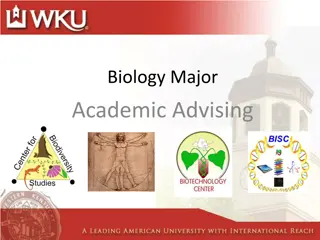Key Concepts in Biology and Chemistry
Exploring the fundamentals of biology and chemistry, including methods for problem-solving, characteristics of life, organic compounds in organisms, and the role of enzymes in metabolism. Learn about cellular organization, reproduction, metabolism, homeostasis, heredity, response to stimuli, growth and development, evolutionary adaptation, macromolecules like carbohydrates, lipids, proteins, and nucleic acids, as well as the chemistry of life and enzymatic reactions.
Download Presentation

Please find below an Image/Link to download the presentation.
The content on the website is provided AS IS for your information and personal use only. It may not be sold, licensed, or shared on other websites without obtaining consent from the author.If you encounter any issues during the download, it is possible that the publisher has removed the file from their server.
You are allowed to download the files provided on this website for personal or commercial use, subject to the condition that they are used lawfully. All files are the property of their respective owners.
The content on the website is provided AS IS for your information and personal use only. It may not be sold, licensed, or shared on other websites without obtaining consent from the author.
E N D
Presentation Transcript
Science Methods Steps used to solve a problem Observation Questioning and stating problems Hypothesizing Experimenting including a control and experimental group IV independent variable DV dependent variable Tables and Graphs IV on x-axis and DV on y-axis of a graph Ex) Effects of pH on Tadpole Survival IV pH DV-Number of Tadpoles
Characteristics of Life All living things exhibit several basic life characteristics: Cellular organization *unicellular one celled * multicellular many celled with levels of organization (cells tissues organs systems organism) Reproduction *asexual offspring are genetic clones of parent *sexual offspring have genetic variation from parents Metabolism * energy is required for life processes * autotrophs make their own food (photosynthesis/chemosynthesis) * heterotrophs eat other organisms for food Homeostasis * maintenance or regulation of body conditions such as body temperature, blood sugar level, water balance Heredity * DNA deoxyribonucleic acid is the genetic material that codes for proteins of all organisms. The genetic code is universal Response to stimuli * responding to the biotic and abiotic factors in the environment are key to survival Growth and Development * growth increase in the amount of living matter either by cell division or cell enlargement * development any change from conception to death - embryonic, puberty, aging Evolutionary Adaptation * adaptations structures, behaviors, or processes that aid in an organisms survival are passed on from parent to offspring.
Chemistry Organisms are composed of organic compounds carbon containing compounds that can be very large macromolecules Macromolecules are often built by dehydration synthesis and polymerization Four main types 1) Carbohydrates composed of monosaccharides primarily glucose 2) Lipids composed of fatty acids joined to glycerol and sometimes phosphate groups, can also include the steroids 3) Proteins composed of amino acids (20 different types) do most of the work in organisms and are major structural components 4) Nucleic Acids are composed of nucleotides either DNA or RNA Metabolism is the chemistry of life all metabolism is controlled by the action of enzymes Enzymes are proteins that function to speed up chemical reactions in the cell. They have a specific shape and interact with a specific substrate which binds at the active site. Enzymes are reusable and are not changed during a chemical reaction. They can be damaged at temperature and pH extremes.
Ecology Ecology is the study of interactions between organisms and the environment Levels of Organization Biosphere Biomes Ecosystem Community Population Organism We study an organisms habitat, niche, and trophic level Populations are members of the same species living in the same place at the same time with the potential to interbreed Population growth exponential (J-shape) and logistic (S-Shape) * Limited by factors like disease and competition that are density- dependent or by density-independent factors like natural disaster. * Carrying capacity is seen in logistic growth the maximum number the environment can support Community Interactions * Competition intraspecific (same species) or interspecific (diff sp) * Symbiosis parasitism, commensalism, and mutualism * Succession both primary (bare rock) and secondary (soil) Ecosystem Level food chains and webs and matter recycling
Cells Cell theory - 3 parts 1) cells are basic unit of life 2) cells come from existing cells 3) all organisms are composed of cells Prokaryotic versus Eukaryotic A) simple B) has no nucleus C) has no MB organelles D) includes bacteria A) complex B) has a MB nucleus C) has MB organelles D) includes protists, fungi, plants, and animals Organelles compartments for carrying out specific jobs / chemical reactions 1) chloroplast photosynthesis 2) mitochondria cellular respiration 3) ribosomes protein synthesis 4) vacuoles storage 5) nucleus contains DNA and controls cell actions 6) nucleolus site of ribosome formation Plant versus Animal A) has cell wall B) has chloroplasts/plastids B) has no plastids/chloroplasts C) has large vacuole C) has small vacuoles A) no cell wall
Cellular Transport Plasma membrane controls homeostasis (balance) Structure composed of a phospholipid bilayer with embedded proteins gates Function acts as a selectively permeable boundary around the cell Types of Passive Transport no energy required 1) Diffusion moves substances from high to low concentrations down their concentration gradient 2) Osmosis the diffusion of water from high to lower water concentrations down its concentration gradient Ex) cell in salt water shrivelsEx) cell in fresh water swells 3) Facilitated diffusion movement of a substance down its concentration through a transport protein channel Active Transport requires energy moves substances against the concentration gradient from low to high concentrations
Photosynthesis The process used by producers to convert sunlight to chemical energy in glucose Overall equation: 6CO2 + 6H2O Occurs in the palisade layer of leaves (yellow layer under the upper epidermis) C6H12O6 + 6O2 Large numbers of chloroplasts are found in these mesophyll cells. Chloroplasts are the cellular site of photosynthesis. The light reaction of photosynthesis occurs on the inner membrane called the thylakoid. The dark reaction (aka Calvin Cycle) occurs in the stroma Pigments absorb light energy Chlorophyll / carotenoids Input Output Light Reaction light, water O2, ATP NADPH Dark Reaction ATP, CO2 GLUCOSE NADPH
Cellular Respiration Cellular respiration is the process by which organisms break down food to release its energy. This energy is then stored in ATP (Adenosine triphosphate) Three parts to ATP 1) adenine (Nbase) 2) ribose (5-C sugar) 3) 3 phosphates (high energy) ATP/ADP cycle when energy is needed for cell work ATP loses a phosphate to become ADP Overall equation: C6H12O6 + 6O2 Respiration can be aerobic or anaerobic Aerobic Anaerobic O2 required no O2 required most organisms are aerobes few anaerobes (yeast/bacteria) 38 ATP 2 ATP 3 steps glycolysis, Krebs cycle, 2 steps glycolysis and electron transport fermentation (alcoholic and 6CO2 + 6H2O + 38 ATP lactic acid) Glycolysis is the first step of both forms of respiration and occurs in the cytoplasm If no oxygen is present after glycolysis, then fermentation occurs If oxygen is present, then the Krebs cycle and e-transport occur in the mitochondria
DNA, RNA, and Protein Synthesis DNA and RNA are composed of nucleotides DNA RNA____________ Deoxyribose Ribose A, C, G A, C, G Thymine Uracil Double helix Single helix Codes for proteins/RNA Copy of DNA info Replication the process used by cells to copy DNA enzyme unzips DNA and each side of the ladder acts as a template for the building of the new half. Use the N-base paring rules : A-T ; C-G EX) TACGGAC (old strand) ATGCCTG (new strand Transcription the process of making RNA from DNA EX) TACGGAC (template DNA strand) AUGCCUG (RNA built) 3 Types of RNA have a role in protein synthesis 1) mRNA messenger-blueprint for how to build protein 2) tRNA transfer - carries amino acids to ribosome 3) rRNA ribosomal makes up a ribosome Translation the process of of building a protein by matching Codons in mRNA to anticodons of tRNA (use codon chart)
Reproduction Reproduction is a fundamental characteristic of life Propagates your species 2 form: asexual and sexual Asexual Sexual____________ -1 parent -No gametes -Offspring are genetically identical -Offspring genetically unique to the parent (clones) -Fast, efficient, less energy -No variation -Stable Environment -2 parents (usually) -Fusion of gametes -Slower, less efficient, more energy -Huge amounts of variation -Changing Environment Asexual Strategies 1) binary fission 2) budding 3) fragmentation/fission Sexual strategies 1) Internal fertilization Copulation (vagina/penis) sperm meets egg in female 2) External fertilization Spawning eggs and sperm released into the environment usually aquatic In humans fertilization occurs in the fallopian tube.
Cell Division Haploid having one set of chromosomes (n) gametes sperm/egg Diploid having two sets of chromosomes (2n) body cells one set is maternal and one is paternal The cell cycle Interphase growth - Mitosis division Mitosis creates diploid cells and is for the purpose of tissue repair and growth in animals DNA coils to form chromosomes during cell division Stages of the cell cycle ( see diagram) Interphase, Prophase, Metaphase, Anaphase, Telophase, Cytokinesis Meiosis cell division that creates 4 haploid cells called gametes aka reduction division Meiosis involves 2 divisions Meiosis I and Meiosis II Meiosis I has some special events: In Prophase I homologous chromosomes pair up and crossing over occurs. This recombination increases genetic variation for the species Metaphase I Pairs line up Anaphase I pairs are separated Meiosis II is similar to mitosis
Simple Genetics Gregor Mendel worked with pea plants to learn the basic patterns of inheritance. Phenotype what the organism looks like Genotype the gene combination either Homozygous (TT or tt) or Heterozygous (Tt) Monohybrid Cross follows 1 trait through several generations P(parental) TT x tt T T T t t geno- all Tt T t pheno all tall t Other important monohybrid crosses T t T t T geno- TT; Tt t T pheno all Tall t Tt Tt geno TT, Tt, tt pheno Tall; short (3:1 ratio) Tt Tt TT Tt Tt Tt Tt tt geno Tt; tt pheno Tall; short Tt Tt Tt Tt tt Tt Dihybrid cross follows two traits Note 9:3:3:1 phenotypic ratio
Complex Genetics Incomplete Dominance intermediate/blended phenotype Ex) snap dragons Red (RR) X White (R R ) R R geno- all RR R geno- RR; RR ; R R R all Pink R R RR RR RR RR RR RR RR R R R pheno-all pinkR pheno- red; pink; white Codominance both parental phenotypes show up in offspring Ex) Chickens Black x White Black and White feathers Multiple Allelism trait with 3+ alleles ex) A, B, O blood types Sex Linkage genes carried on sex chromosomes Ex) hemophilia, color blindness Cross shows a carrier female and a normal male. For a female to inherit the trait the father must have it and the mother must at least be a carrier Polygenic Inheritance traits controlled by many genes Ex) Height, hair color Aneuploidy condition caused by having abnormal chromosome number. Ex) Down s Syndrome aka Trisomy 21
DNA Technology 1)DNA Extraction the opening of cells to separate/isolate DNA from other cell parts 2)Cutting DNA large DNA molecules are cut into smaller fragments using restriction enzymes. These enzymes recognize and cut DNA at specific sequences. See Fig 13-5 p322. Today, DNA techniques include: 3)Separating DNA DNA fragments can be separated and analyzed using gel electrophoresis. This process allows scientists to compare genomes of different organisms, separate genes, and create DNA fingerprints 4)Sequencing DNA this process allows scientists to determine the sequence of N-bases in DNA. 5)Recombinant DNA scientists can cut DNA from two sources with the same restriction enzyme and combine them. This is used in genetic engineering. This process has been used to create human proteins used to treat disease, create pest-resistant crops, and for many other purposes. 6)Copying DNA polymerase chain reaction (PCR) has been developed that makes many copies of a small amount of DNA. See Fig 13-8 p325.
Evolution Charles Darwin proposed that organisms (species or populations) change over time Occurs by Natural Selection survival of the fittest Lines of evidence 1) fossils (geologic time) 2) Homologous Structures same basic structure formed from same embryonic tissue 3) Analogous Structures same basic functions due to same environmental pressures 4) Vestigial Structures structures that have lost function ex) appendix 5) Embryology embryos of various species appear identical 6) Biochemistry DNA and protein amino acid sequence comparisons Adaptive radiation an ancestral species radiates or diverges into many species. Ex) Galapagos Finches Origin Ideas Urey and Miller simulated Earth s early environment and created organic compounds like amino acid Endosymbiont theory eukaryotic cells formed when prokaryotic cells began to live together permanently Homologous Vestigial
Classification Carolus Linnaeus developed 7 categories of classification Also developed binomial nomenclature naming using the genus and species names to refer to an organism Classification tools include dichotomous keys a series of paired statements that lead to the name of an organism 1a) Object has no sides . . . . . . . . . . . . . .Go to 2 1b) Object has sides . . . . . . . . . . . . . . . . . Go to 3 2a) Object is oblong . . . . . . . . . . . . . . . . . oval 2b) Object is symmetrical . . . . . . . . . . . circle 3a) Object has 3 sides . . . . . . . . . . . . . . . triangle 3b) Object has 4 sides . . . . . . . . . . . . . . . Go to 4 4a) Object has 4 equal sides . . . . . . . . . . square 4b) Object doesn t have 4 equal sides . . rectangle
Kingdoms http://www.ric.edu/ptiskus/Six_Kingdoms/Index.htm How are organism placed into their kingdoms? 1) Cell type, complex or simple 2) Their ability to make food 3) The number of cells in their body Five Kingdom System Monera all prokaryotic includes the bacteria Protista most are unicellular, eukaryotic, and aquatic Fungi all eukaryotic heterotrophs that act as decomposers Plantae all eukaryotic autotrophs Animalia all eukaryotic heterotrophs that must eat other organisms for food In Six Kingdom system the Kingdom Monera has been divided into the Archaebacteria and the Eubacteria Archaebacteria are extremists that live in hot, acidic, saline, or other harsh environments Eubacteria are true bacteria that come in 3 shapes 1) round (coccus) 2) rod (bacillus) 3) spiral (spirillus)
Plants Plant cell structure cell walls, large vacuole, chloroplasts Photosynthesis Classification 4 groups 1) Nonvascular no true roots/stems/leaves ex) mosses (Bryophytes) 2) Seedless vascular plants Ferns 3) Vascular with seeds in cones Gymnosperms (pines, fir, spruce) 4) Vascular with seeds in fruits Angiosperms flowering plants Types of Vascular Tissue A) Xylem transports water from roots to leaves B) Phloem transports sugars from leaves to roots Reproductive Life Cycle called Alternation of Generations Tropisms growth responses to stimuli often controlled by hormones like auxins and gibberellins Phototropism Gravitropism Thigmotropism
Animals Modes of reproduction Animal cell structure no cell wall, small vacuoles, no plastids, centrioles Classification 2 main groups Vertebrates Invertebrates Phylum Chordata 3 classes of fish Amphibians Reptiles Aves (birds) Mammals 9 Phyla Arthropods insects (6 legs) (exoskeleton) - arachnids (8 legs) - crustaceans Mollusks have shell created by structure called mantel Human Anatomy Look through the chapters in your book regarding anatomy. * Neurons * Heart * Kidneys Animal Behavior responses that allow an organism to respond to stimuli 1) Innate Behavior instincts, inherited, inborn behaviors ex) circadian rhythms daily patterns of activity including feeding behaviors - nocturnal ex) annual rhythms yearly patterns of activity including courtship, estivation, hibernation, migration 2) Learned Behavior based on experience ex) imprinting recognition of parents ex) Trial and error learning ex) Conditioning (Pavlov s dog) learning by association 3) Social Behavior division of labor as in a termite or ant colony
Biologists Robert Hooke discovered and named the cell with crude microscope Anton van Leeuwenhoek - saw wee little beasties living cells for the first time Gregor Mendel is the father of genetics discovered the basic patterns of inheritance in pea plants Charles Darwin is the father of evolution theory proposed that organisms that are most fit or best adapted to their environment are more likely to survive called Natural Selection James Watson and Francis Crick discovered the double helix structure of DNA by examining an x-ray made by Rosalind Franklin and Maurice Wilkins Charles Drew associated with our understanding of the ABO blood groups and transfusion Carolus Linnaeus binomial nomenclature and classification of organisms Rachel Carson wrote Silent Spring bringing to public attention the dangers of pesticides particularly DDT this toxin bioaccumulates in the bodies of top consumers Jane Goodall studied chimpanzee behavior Louis Pasteur helped disprove abiogenesis or spontaneous generation by creating a s-neck flask and showing that microorganisms spoil food
